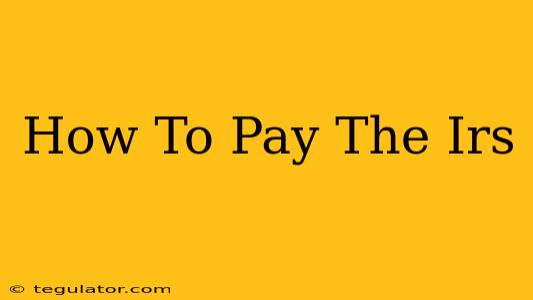Paying your taxes can feel daunting, but understanding your options makes the process much smoother. This guide breaks down the various ways you can pay your IRS taxes, helping you choose the method that best suits your needs.
Understanding Your Tax Liability
Before diving into payment methods, ensure you've accurately calculated your tax liability. Use the appropriate IRS forms and instructions, and consider seeking professional tax advice if needed. Incorrectly calculating your tax liability can lead to penalties and interest.
Gathering Necessary Information
Before making a payment, gather the following:
- Your Social Security Number (SSN) or Individual Taxpayer Identification Number (ITIN): This is crucial for accurate identification.
- Tax Year: Specify the year for which you're making the payment.
- Tax Form or Notice Number: This helps the IRS identify the specific tax liability.
- Payment Amount: Ensure you have the correct amount calculated.
IRS Payment Methods: A Detailed Overview
The IRS offers several convenient methods to pay your taxes. Let's explore each option:
1. IRS Direct Pay
IRS Direct Pay is a free service allowing you to make payments directly from your checking account or savings account. It's a secure and reliable method, offering real-time confirmation of your payment. This is a strong option for those who prefer electronic payments and immediate confirmation.
2. Debit Card, Credit Card, or Digital Wallet
The IRS accepts payments through third-party payment processors that use debit cards, credit cards (Visa, Mastercard, American Express, Discover), and digital wallets like PayPal and Apple Pay. Note: These processors typically charge a small processing fee.
3. Electronic Funds Withdrawal (EFW)
When filing your taxes electronically using tax preparation software or through a tax professional, you can choose Electronic Funds Withdrawal. This directly debits your bank account, offering a secure and convenient way to pay.
4. Check or Money Order
While less convenient than electronic methods, you can still pay via mail using a check or money order. Make sure to include your name, address, phone number, SSN or ITIN, the tax year, and the relevant tax form or notice number. Mail your payment to the address specified on the notice or tax form. Never send cash through the mail.
5. Cash
You can pay your taxes in person at one of the IRS's retail partners, such as Dollar General, CVS, Walgreens, Walmart, and Kroger. This method requires using a payment processor and usually involves a small fee. Always verify the legitimacy of the payment processor and retail partner before making a payment.
6. Electronic Federal Tax Payment System (EFTPS)
EFTPS is a free service allowing individuals and businesses to make tax payments electronically. This option offers various payment methods and scheduling features. It's particularly useful for businesses making frequent tax payments.
Avoiding Penalties and Interest
- Pay on Time: Paying your taxes on time is crucial to avoid penalties and interest. The IRS assesses penalties for late payments.
- Accurate Payment: Always ensure you're paying the correct amount to prevent further complications.
- Keep Records: Maintain records of all your tax payments, including payment confirmations and receipts.
Choosing the Right Payment Method
The best payment method depends on your preferences and circumstances. Consider factors like convenience, fees, and security when making your choice. If you're unsure which method to choose, the IRS website provides detailed information and guidance. Don't hesitate to contact the IRS directly if you have any questions or require assistance.
By understanding these various payment options and following these guidelines, you can confidently and accurately pay your IRS taxes, avoiding unnecessary penalties and complications. Remember to always prioritize secure and reliable payment methods.

